

Compact Muon Solenoid
LHC, CERN
| CMS-EXO-16-039 ; CERN-EP-2017-097 | ||
| Search for new physics in the monophoton final state in proton-proton collisions at $ \sqrt{s} = $ 13 TeV | ||
| CMS Collaboration | ||
| 12 June 2017 | ||
| J. High Energy Phys. 10 (2017) 073 | ||
| Abstract: A search is conducted for new physics in a final state containing a photon and missing transverse momentum in proton-proton collisions at $ \sqrt{s} = $ 13 TeV. The data collected by the CMS experiment at the CERN LHC correspond to an integrated luminosity of 12.9 fb$^{-1}$. No deviations are observed relative to the predictions of the standard model. The results are interpreted as exclusion limits on the dark matter production cross sections and parameters in models containing extra spatial dimensions. Improved limits are set with respect to previous searches using the monophoton final state. In particular, the limits on the extra dimension model parameters are the most stringent to date in this channel. | ||
| Links: e-print arXiv:1706.03794 [hep-ex] (PDF) ; CDS record ; inSPIRE record ; CADI line (restricted) ; | ||
| Figures | |

png pdf |
Figure 1:
Leading-order diagrams of the simplified DM model (left), electroweak-DM effective interaction (center), and graviton (G) production in the ADD model (right), with a final state of $\gamma $ and large ${ {p_{\mathrm {T}}} ^\text {miss}} $. |
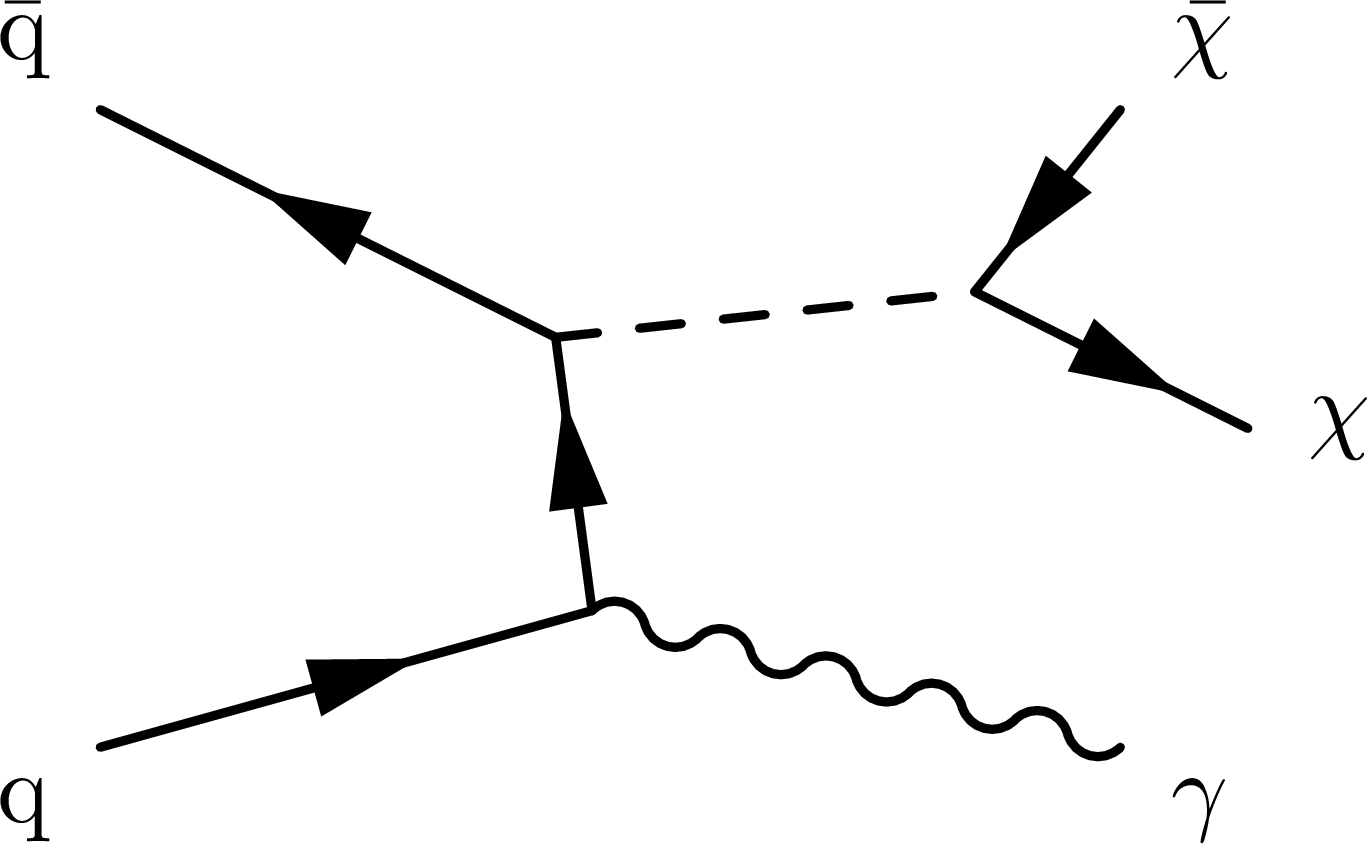
png pdf |
Figure 1-a:
Leading-order diagrams of the simplified DM model, with a final state of $\gamma $ and large ${ {p_{\mathrm {T}}} ^\text {miss}} $. |
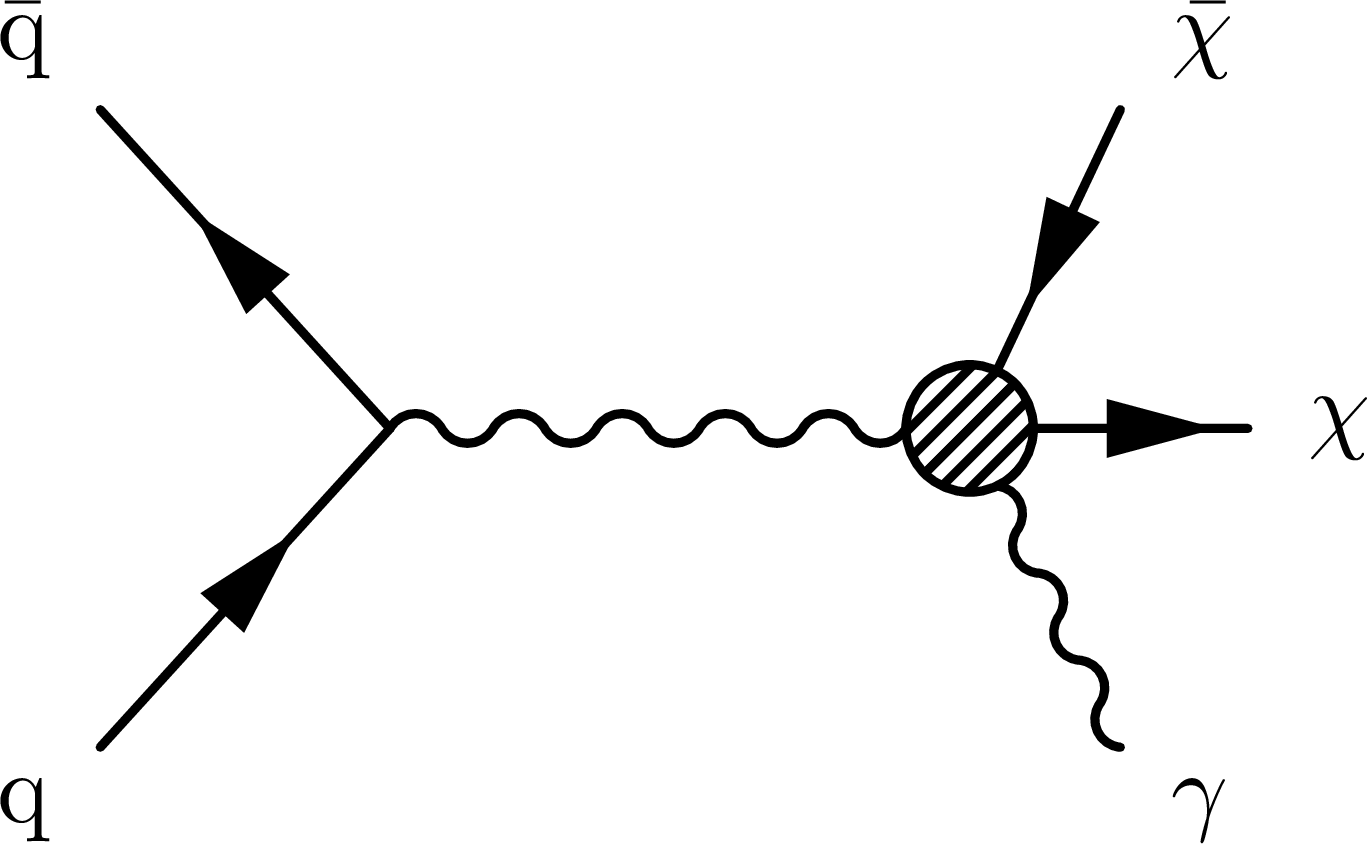
png pdf |
Figure 1-b:
Leading-order diagrams of the electroweak-DM effective interaction, with a final state of $\gamma $ and large ${ {p_{\mathrm {T}}} ^\text {miss}} $. |

png pdf |
Figure 1-c:
Leading-order diagrams of the graviton (G) production in the ADD model, with a final state of $\gamma $ and large ${ {p_{\mathrm {T}}} ^\text {miss}} $. |

png pdf |
Figure 2:
The ${p_{\mathrm {T}}^{\gamma }}$ (left) and ${ {p_{\mathrm {T}}} ^\text {miss}} $ (right) distributions for the candidate sample, compared with estimated contributions from SM backgrounds. In the legends, "others'' includes the contribution from $\gamma$+jets, $\mathrm{ W } \to \ell \nu $, ${\mathrm{ Z } (\to \ell \overline {\ell })}$+${\gamma }$, and $\mathrm{ t \bar{t} }\gamma$ backgrounds. The background uncertainties include statistical and systematic components. The last bin includes the overflow. The lower panel shows the ratio of data and SM background predictions, where the hatched band shows the systematic uncertainty. |
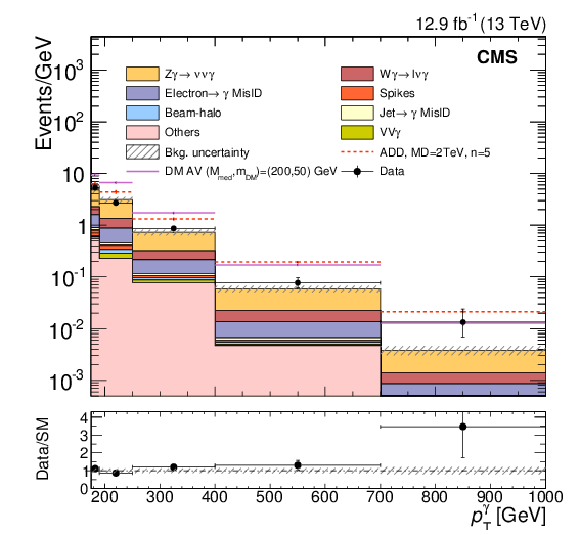
png pdf |
Figure 2-a:
The ${p_{\mathrm {T}}^{\gamma }}$ distribution for the candidate sample, compared with estimated contribution from SM backgrounds. In the legend, "others'' includes the contribution from $\gamma$+jets, $\mathrm{ W } \to \ell \nu $, ${\mathrm{ Z } (\to \ell \overline {\ell })}$+${\gamma }$, and $\mathrm{ t \bar{t} }\gamma$ backgrounds. The background uncertainties include statistical and systematic components. The last bin includes the overflow. The lower panel shows the ratio of data and SM background predictions, where the hatched band shows the systematic uncertainty. |
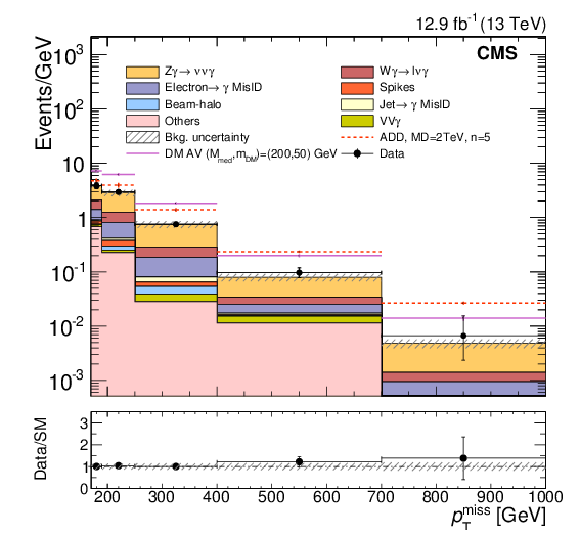
png pdf |
Figure 2-b:
The ${ {p_{\mathrm {T}}} ^\text {miss}} $ distribution for the candidate sample, compared with estimated contribution from SM backgrounds. In the legend, "others'' includes the contribution from $\gamma$+jets, $\mathrm{ W } \to \ell \nu $, ${\mathrm{ Z } (\to \ell \overline {\ell })}$+${\gamma }$, and $\mathrm{ t \bar{t} }\gamma$ backgrounds. The background uncertainties include statistical and systematic components. The last bin includes the overflow. The lower panel shows the ratio of data and SM background predictions, where the hatched band shows the systematic uncertainty. |

png pdf |
Figure 3:
The ratio of 95% CL cross section upper limits to theoretical cross section ($\mu _{95}$), for DM simplified models with vector (left) and axial-vector (right) mediators, assuming $ g_{\mathrm{q}}= $ 0.25 and $ g_{\text{DM}}= $ 1. Expected and observed $\mu _{95} = $ 1 contours are overlaid. The region below the observed contour is excluded. |

png pdf |
Figure 3-a:
The ratio of 95% CL cross section upper limits to theoretical cross section ($\mu _{95}$), for DM simplified models with vector mediators, assuming $ g_{\mathrm{q}}= $ 0.25 and $ g_{\text{DM}}= $ 1. Expected and observed $\mu _{95} = $ 1 contours are overlaid. The region below the observed contour is excluded. |
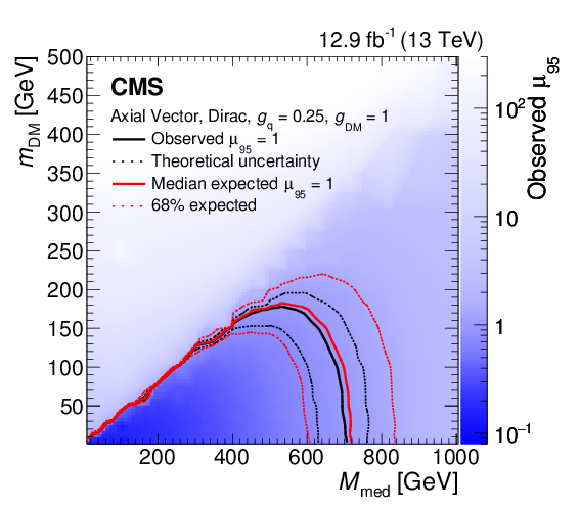
png pdf |
Figure 3-b:
The ratio of 95% CL cross section upper limits to theoretical cross section ($\mu _{95}$), for DM simplified models with axial-vector mediators, assuming $ g_{\mathrm{q}}= $ 0.25 and $ g_{\text{DM}}= $ 1. Expected and observed $\mu _{95} = $ 1 contours are overlaid. The region below the observed contour is excluded. |
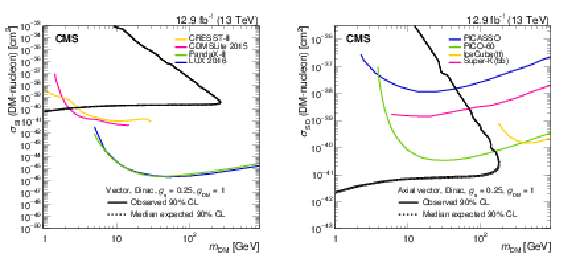
png pdf |
Figure 4:
The 90% CL exclusion limits on the $\chi $-nucleon spin-independent (left) and spin-dependent (right) scattering cross sections involving vector and axial-vector operators, respectively, as a function of the ${m_{\text {DM}}}$. Simplified model DM parameters of $ g_{\mathrm{q}}= $ 0.25 and $ g_{\text{DM}}= $ 1 are assumed. The region to the upper left of the contour is excluded. On the plots, the median expected 90% CL curve overlaps the observed 90% CL curve. Also shown are corresponding exclusion contours, where regions above the curves are excluded, from the recent results by CDMSLite [39], LUX [40], PandaX [41], CRESST-II [42], PICO-60 [43], IceCube [44], PICASSO [45] and Super-Kamiokande [46] Collaborations. |

png pdf |
Figure 4-a:
The 90% CL exclusion limits on the $\chi $-nucleon spin-independent scattering cross sections involving vector and axial-vector operators, respectively, as a function of the ${m_{\text {DM}}}$. Simplified model DM parameters of $ g_{\mathrm{q}}= $ 0.25 and $ g_{\text{DM}}= $ 1 are assumed. The region to the upper left of the contour is excluded. On the plots, the median expected 90% CL curve overlaps the observed 90% CL curve. Also shown are corresponding exclusion contours, where regions above the curves are excluded, from the recent results by CDMSLite [39], LUX [40], PandaX [41] and CRESST-II [42] Collaborations. |
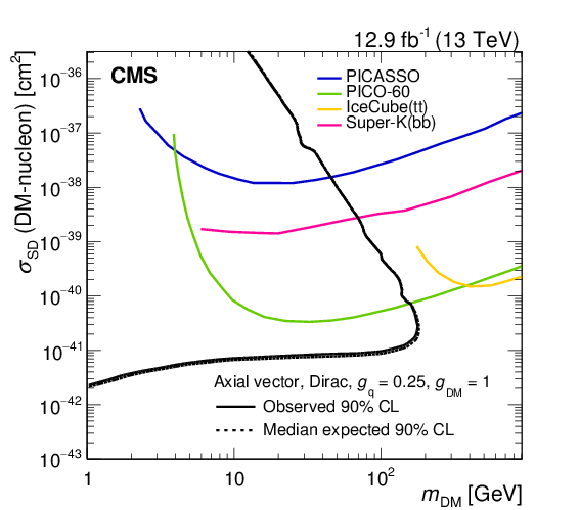
png pdf |
Figure 4-b:
The 90% CL exclusion limits on the $\chi $-nucleon spin-dependent scattering cross sections involving vector and axial-vector operators, respectively, as a function of the ${m_{\text {DM}}}$. Simplified model DM parameters of $ g_{\mathrm{q}}= $ 0.25 and $ g_{\text{DM}}= $ 1 are assumed. The region to the upper left of the contour is excluded. On the plots, the median expected 90% CL curve overlaps the observed 90% CL curve. Also shown are corresponding exclusion contours, where regions above the curves are excluded, from the recent results by PICO-60 [43], IceCube [44], PICASSO [45] and Super-Kamiokande [46] Collaborations. |
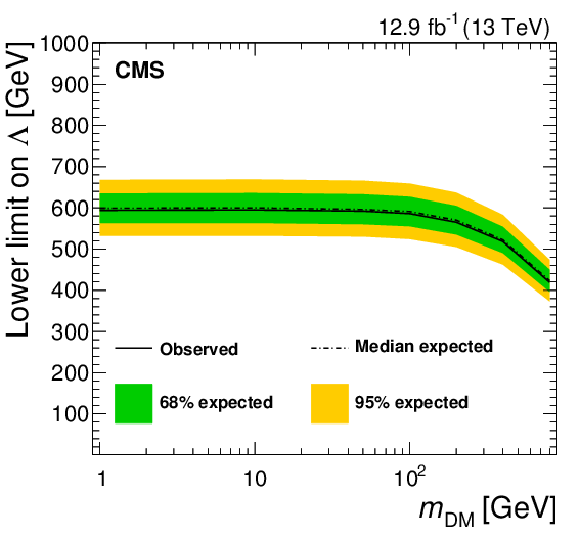
png pdf |
Figure 5:
The 95% CL expected and observed lower limits on $\Lambda $ as a function of ${m_{\text {DM}}}$, for a dimension-7 operator EFT model. |
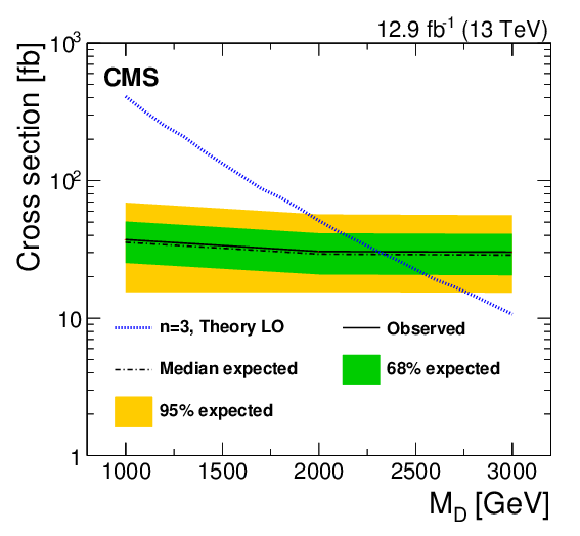
png pdf |
Figure 6:
The 95% CL upper limits on the ADD graviton production cross section, as a function of ${M_D}$ for $n=3$ extra dimensions. |

png pdf |
Figure 7:
Lower limit on ${M_D}$ as a function of $n$, the number of ADD extra dimensions. |
| Tables | |
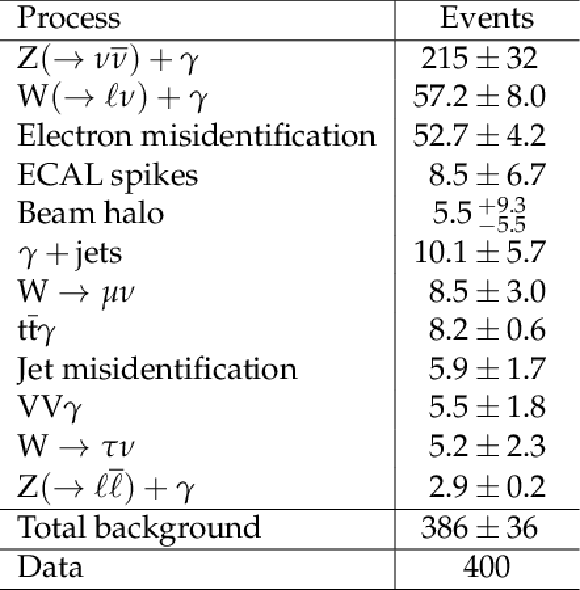
png pdf |
Table 1:
Summary of estimated background and observed candidate events. The quoted uncertainties for the background estimates are obtained by adding the systematic and statistical uncertainties in quadrature. |
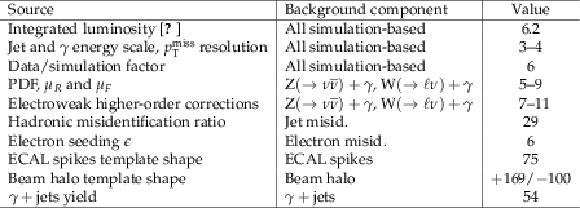
png pdf |
Table 2:
Summary of relative systematic uncertainties (%) for different background estimates. The middle column indicates the component of the estimated SM background that is affected by each uncertainty. |
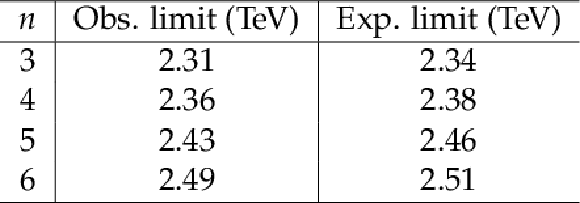
png pdf |
Table 3:
The 95% CL observed and expected lower limits on ${M_D}$ as a function of $n$, the number of ADD extra dimensions. |
| Summary |
| Proton-proton collisions producing large missing transverse momentum and a high transverse momentum photon have been investigated to search for new phenomena, using a data set corresponding to 12.9 fb$^{-1}$ of integrated luminosity recorded at $ \sqrt{s} = $ 13 TeV at the CERN LHC. No deviations from the standard model predictions are observed. Constraints are set on the production cross sections for dark matter and large extra dimension gravitons at 95% confidence level, which are then translated to limits on the parameters of the individual models. For the simplified dark matter production models considered, the search excludes mediator masses of up to 700 GeV for low-mass dark matter. For an effective dimension-7 photon-dark matter contact interaction, values of $\Lambda$ up to 600 GeV are excluded. For the ADD model with extra spatial dimensions, values of the fundamental Planck scale up to 2.31-2.49 TeV, depending on the number of extra dimensions, are excluded. These are the most stringent limits to date using the monophoton final state. |
| References | ||||
| 1 | R. J. Gaitskell | Direct detection of dark matter | Ann. Rev. Nucl. Part. Sci. 54 (2004) 315 | |
| 2 | P. J. Fox, R. Harnik, J. Kopp, and Y. Tsai | Missing energy signatures of dark matter at the LHC | PRD 85 (2012) 056011 | 1109.4398 |
| 3 | J. Goodman et al. | Constraints on dark matter from colliders | PRD 82 (2010) 116010 | 1008.1783 |
| 4 | L. Susskind | Dynamics of spontaneous symmetry breaking in the weinberg-salam theory | PRD 20 (1979) 2619 | |
| 5 | N. Arkani-Hamed, S. Dimopoulos, and G. Dvali | The hierarchy problem and new dimensions at a millimeter | PLB 429 (1998) 263 | hep-ph/9803315 |
| 6 | N. Arkani-Hamed, S. Dimopoulos, and G. Dvali | Phenomenology, astrophysics, and cosmology of theories with submillimeter dimensions and tev scale quantum gravity | PRD 59 (1999) 086004 | |
| 7 | D. Abercrombie et al. | Dark matter benchmark models for early LHC Run-2 searches: Report of the ATLAS/CMS Dark Matter Forum | 1507.00966 | |
| 8 | A. Nelson et al. | Confronting the Fermi line with LHC data: An effective theory of dark matter interaction with photons | PRD 89 (2014) 056011 | 1307.5064 |
| 9 | CMS Collaboration | Search for new phenomena in monophoton final states in proton-proton collisions at $ \sqrt{s} = $ 8 TeV | PLB 755 (2016) 102 | CMS-EXO-12-047 1410.8812 |
| 10 | ATLAS Collaboration | Search for new phenomena in events with a photon and missing transverse momentum in $ pp $ collisions at $ \sqrt{s} = $ 13 TeV with the ATLAS detector | JHEP 06 (2016) 059 | 1604.01306 |
| 11 | CMS Collaboration | Performance of photon reconstruction and identification with the CMS detector in proton-proton collisions at $ \sqrt{s} = $ 8 TeV | JINST 10 (2015) P08010 | CMS-EGM-14-001 1502.02702 |
| 12 | CMS Collaboration | The CMS experiment at the CERN LHC | JINST 3 (2008) S08004 | CMS-00-001 |
| 13 | CMS Collaboration | The CMS trigger system | JINST 12 (2017), no. 01, P01020 | CMS-TRG-12-001 1609.02366 |
| 14 | CMS Collaboration | Particle--flow event reconstruction in CMS and performance for jets, taus, and $ E_{\mathrm{T}}^{\text{miss}} $ | CMS-PAS-PFT-09-001 | |
| 15 | CMS Collaboration | Commissioning of the particle-flow reconstruction in minimum-bias and jet events from pp collisions at 7 TeV | CMS-PAS-PFT-10-002 | |
| 16 | M. Cacciari, G. P. Salam, and G. Soyez | The anti-$ k_t $ jet clustering algorithm | JHEP 04 (2008) 063 | 0802.1189 |
| 17 | M. Cacciari, G. P. Salam, and G. Soyez | FastJet User Manual | EPJC 72 (2012) 1896 | 1111.6097 |
| 18 | CMS Collaboration | Performance of the CMS missing transverse momentum reconstruction in pp data at $ \sqrt{s} = $ 8 TeV | JINST 10 (2015) P02006 | CMS-JME-13-003 1411.0511 |
| 19 | W. Adam, R. Fruhwirth, A. Strandlie, and T. Todorov | Reconstruction of electrons with the gaussian-sum filter in the cms tracker at the lhc | JPG 31 (2005) N9 | |
| 20 | CMS Collaboration | Performance of electron reconstruction and selection with the CMS detector in proton-proton collisions at $ \sqrt{s} = $ 8 TeV | JINST 10 (2015) P06005 | CMS-EGM-13-001 1502.02701 |
| 21 | CMS Collaboration | CMS luminosity calibration for the pp reference run at $ \sqrt{s} = $ 5.02 TeV | CMS-PAS-LUM-16-001 | CMS-PAS-LUM-16-001 |
| 22 | J. Alwall et al. | The automated computation of tree-level and next-to-leading order differential cross sections, and their matching to parton shower simulations | JHEP 07 (2014) 079 | 1405.0301 |
| 23 | T. Sjostrand et al. | An introduction to PYTHIA 8.2 | CPC 191 (2015) 159 | 1410.3012 |
| 24 | NNPDF Collaboration | Parton distributions for the LHC Run II | JHEP 04 (2015) 040 | 1410.8849 |
| 25 | CMS Collaboration | Event generator tunes obtained from underlying event and multiparton scattering measurements | EPJC 76 (2016) 155 | CMS-GEN-14-001 1512.00815 |
| 26 | GEANT4 Collaboration | Geant4---a simulation toolkit | NIMA 506 (2003) 250 | |
| 27 | J. Allison et al. | Geant4 developments and applications | IEEE Trans. Nucl. Sci 53 (2006) 270 | |
| 28 | CMS Collaboration | Measurements of inclusive W and Z Cross Sections in pp collisions at $ \sqrt{s} = $ 7 TeV | JHEP 01 (2011) 080 | CMS-EWK-10-002 1012.2466 |
| 29 | CMS Collaboration | Measurement of the inclusive W and Z production cross sections in pp collisions at $ \sqrt{s} = $ 7 TeV with the CMS experiment | JHEP 10 (2011) 132 | CMS-EWK-10-005 1107.4789 |
| 30 | S. Catani, D. de Florian, G. Ferrera, and M. Grazzini | Vector boson production at hadron colliders: transverse-momentum resummation and leptonic decay | JHEP 12 (2015) 047 | 1507.06937 |
| 31 | A. Denner, S. Dittmaier, M. Hecht, and C. Pasold | NLO QCD and electroweak corrections to W+$ \gamma $ production with leptonic W-boson decays | JHEP 04 (2015) 018 | 1412.7421 |
| 32 | A. Denner, S. Dittmaier, M. Hecht, and C. Pasold | NLO QCD and electroweak corrections to Z$ +\gamma $ production with leptonic Z-boson decays | JHEP 02 (2016) 057 | 1510.08742 |
| 33 | CMS Collaboration | Jet algorithms performance in 13 TeV data | CMS-PAS-JME-16-003 | CMS-PAS-JME-16-003 |
| 34 | CMS Collaboration | Isolated photon reconstruction and identification at $ \sqrt{s} = $ 7 TeV | CMS-PAS-EGM-10-006 | |
| 35 | T. Junk | Confidence level computation for combining searches with small statistics | NIMA 434 (1999) 435 | hep-ex/9902006 |
| 36 | A. L. Read | Presentation of search results: The $ CL_s $ technique | JPG 28 (2002) 2693 | |
| 37 | The ATLAS and CMS Collaborations and the LHC Higgs Combination Group | Procedure for the LHC Higgs boson search combination in Summer 2011 | ||
| 38 | G. Cowan, K. Cranmer, E. Gross, and O. Vitells | Asymptotic formulae for likelihood-based tests of new physics | EPJC 71 (2011) 1554 | 1007.1727 |
| 39 | G. Busoni et al. | Recommendations on presenting LHC searches for missing transverse energy signals using simplified $ s $-channel models of dark matter | 1603.04156 | |
| 40 | SuperCDMS Collaboration | New results from the search for low-mass weakly interacting massive particles with the CDMS low ionization threshold experiment | PRL 116 (2016) 071301 | 1509.02448 |
| 41 | LUX Collaboration | Results from a search for dark matter in the complete LUX exposure | PRL 118 (2017) 021303 | 1608.07648 |
| 42 | PandaX-II Collaboration | Dark matter results from first 98.7 days of data from the PandaX-II experiment | PRL 117 (2016) 121303 | 1607.07400 |
| 43 | CRESST Collaboration | Results on light dark matter particles with a low-threshold CRESST-II detector | EPJC 76 (2016) 25 | 1509.01515 |
| 44 | PICO Collaboration | Dark matter search results from the PICO-60 C$ _3 $F$ _8 $ bubble chamber | 1702.07666 | |
| 45 | IceCube Collaboration | Improved limits on dark matter annihilation in the Sun with the 79-string IceCube detector and implications for supersymmetry | JCAP 04 (2016) 022 | 1601.00653 |
| 46 | E. Behnke et al. | Final results of the PICASSO dark matter search experiment | Astropart. Phys. 90 (2017) 85 | 1611.01499 |
| 47 | Super-Kamiokande Collaboration | Search for neutrinos from annihilation of captured low-mass dark matter particles in the sun by Super-Kamiokande | PRL 114 (2015) 141301 | 1503.04858 |
| 48 | G. F. Giudice, R. Rattazzi, and J. D. Wells | Quantum gravity and extra dimensions at high-energy colliders | NPB 544 (1999) 3 | hep-ph/9811291 |

|
Compact Muon Solenoid LHC, CERN |

|

|

|

|

|

|